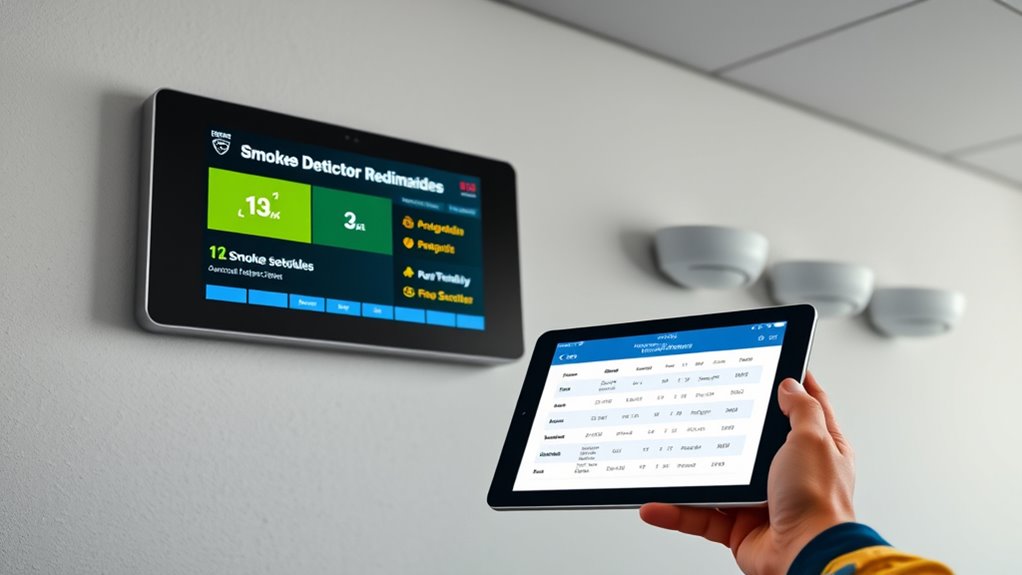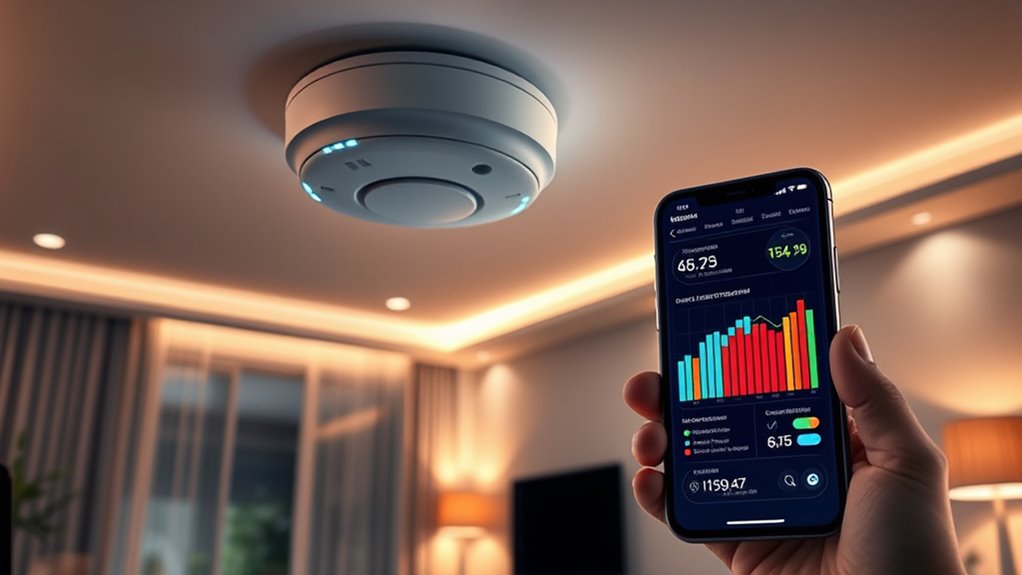By moving to a data-driven approach, you can considerably improve your smoke detector checks. IoT sensors provide real-time performance data, helping you catch early signs of failure or calibration drift. Automated alerts remind you when maintenance is needed, and machine learning predicts potential issues before they happen. This proactive method reduces false alarms and increases safety. To discover how these systems work together and guarantee your home’s safety, keep exploring these smarter solutions.
Key Takeaways
- Utilize real-time sensor data and anomaly detection to monitor smoke detector performance continuously.
- Implement predictive maintenance by analyzing usage patterns and sensor calibration drift.
- Integrate IoT connectivity for remote health checks and automated alerts.
- Apply machine learning algorithms to identify early failures and reduce false alarms.
- Enforce data privacy and security while leveraging insights for proactive safety management.
Understanding the Limitations of Traditional Smoke Detector Maintenance

Traditional smoke detector maintenance often relies on scheduled inspections and manual testing, but these methods can miss early signs of failure. Without proper sensor calibration, detectors might not respond accurately to smoke or fire hazards. Maintenance scheduling often becomes routine, ignoring the device’s actual condition, which can lead to overlooked issues. This approach doesn’t account for sensor degradation over time, risking false alarms or missed detections. Manual checks may confirm functionality at that moment but miss gradual declines in sensitivity. Relying solely on scheduled visits limits your ability to catch problems early. To improve safety, you need more dynamic methods that monitor device performance continuously, rather than just relying on periodic maintenance routines. sensor calibration is essential for maintaining detection accuracy over time.
The Role of Data Analytics in Monitoring Device Performance

Data analytics allows you to monitor smoke detector performance in real time, so you can catch issues before they become serious. With predictive maintenance insights, you can schedule repairs proactively, saving time and costs. Anomaly detection techniques help identify unusual patterns that might indicate device failures or false alarms, keeping your system reliable. Incorporating preventive measures can further enhance system safety and reduce downtime.
Real-Time Performance Tracking
By continuously analyzing performance data in real time, you can instantly identify any deviations or malfunctions in smoke detectors before they become critical. This allows you to promptly address issues like sensor calibration drift, ensuring detectors remain reliable. Real-time tracking also helps you monitor overall device health, reducing false alarms and enhancing safety. Implementing data analytics responsibly means respecting data privacy, so you safeguard sensitive information while optimizing performance. With ongoing performance monitoring, you gain immediate insights, enabling swift interventions and minimizing downtime. This proactive approach ensures your smoke detectors operate efficiently and accurately, providing peace of mind. Leveraging performance data allows for better predictive maintenance, extending the lifespan of your devices and ensuring consistent safety standards. By leveraging real-time data, you stay ahead of potential problems, maintaining safety standards and extending device lifespan.
Predictive Maintenance Insights
Building on real-time performance tracking, predictive maintenance uses data analytics to anticipate potential issues before they impact safety or functionality. By analyzing data from wireless connectivity, you can identify patterns indicating when a smoke detector might fail or need servicing. This proactive approach helps you schedule maintenance before a device malfunctions, reducing false alarms and downtime. Additionally, monitoring battery longevity through data insights ensures you replace batteries at ideal times, preventing unexpected power loss. Wireless connectivity enables seamless data transfer, giving you a thorough view of your detectors’ health. Furthermore, cybersecurity vulnerabilities associated with connected devices highlight the importance of implementing security measures to protect your system from potential cyber threats. With these insights, you can extend device lifespan, maintain reliability, and improve overall safety. Predictive maintenance turns reactive fixes into preventative actions, keeping your smoke detection system efficient and ready when needed.
Anomaly Detection Techniques
When it comes to maintaining reliable smoke detectors, anomaly detection techniques play a vital role in identifying unusual patterns that may indicate potential failures or malfunctions. By analyzing device data, these techniques can spot deviations from normal sensor behavior, helping you catch issues early. For fire safety, timely detection of anomalies ensures detectors remain effective and responsive. Implementing advanced data analytics allows you to monitor sensor calibration over time, identifying calibration drift that could impair performance. This proactive approach minimizes false alarms and prevents hazardous gaps in coverage. Ultimately, anomaly detection enhances your ability to maintain ideal device performance, ensuring that smoke detectors operate correctly when needed most. It’s a fundamental step toward smarter, safer fire safety systems. Additionally, integrating data analytics tools can provide deeper insights into device performance trends, enabling more informed maintenance decisions.
Implementing IoT Sensors for Real-Time Smoke Detector Data Collection

Implementing IoT sensors for real-time smoke detector data collection transforms traditional fire safety systems into intelligent networks. You’ll leverage wireless connectivity to continuously transmit data, enabling immediate responses to detected issues. Proper sensor calibration is essential; it guarantees your devices accurately measure smoke levels and avoid false alarms. By installing these sensors, you gain real-time insights into detector performance and environmental conditions. This proactive approach allows you to identify potential problems before they escalate, enhancing safety and reliability. The integration of IoT technology also simplifies maintenance, as you can remotely monitor sensor health and schedule timely checks. Overall, adopting IoT sensors makes your smoke detection system more responsive, precise, and efficient, considerably improving fire safety management.
Automating Reminder Systems for Routine Checks and Replacements

Automating reminder systems for routine smoke detector checks and replacements guarantees your fire safety measures stay effective without relying on manual tracking. These systems send timely alerts, ensuring you perform necessary tasks like sensor calibration and maintenance before failures occur. By automating reminders, you boost user engagement, making it easier to stay on top of routine checks. This proactive approach minimizes the risk of false alarms or missed detections caused by outdated sensors. You can customize alerts based on device usage or manufacturer recommendations, ensuring each detector remains operational. Automating these reminders not only streamlines maintenance but also maintains *ideal* detector performance, ultimately enhancing your safety and peace of mind.
Analyzing Historical Data to Predict Potential Failures

By analyzing historical data from your smoke detectors, you can identify patterns that indicate potential failures before they happen. Data visualization helps you spot trends in alarm activations, power cycles, or false alarms, making it easier to understand when a detector might be malfunctioning. Pay attention to user behavior, such as irregular testing or inconsistent maintenance, which can contribute to detector issues. Additionally, understanding common issues and troubleshooting can help you interpret data anomalies more accurately. By examining these patterns over time, you gain insight into the conditions that lead to failures. This proactive approach allows you to schedule maintenance before a failure occurs, reducing false alarms and ensuring safety. Leveraging historical data empowers you to make smarter decisions, optimize detector performance, and maintain a reliable safety system.
Integrating Smart Home Systems for Seamless Safety Management

You can connect your smoke detectors to a centralized smart home system, making safety management more efficient. This setup allows automatic alert notifications to reach you instantly if there’s a potential issue. With enhanced safety monitoring, you stay informed and prepared at all times. Additionally, integrating trusted brand reputation ensures reliable performance and peace of mind.
Centralized System Integration
Have you ever wondered how smart home systems can work together to enhance safety? Centralized system integration connects your smoke detectors with other smart devices through wireless connectivity, creating a unified safety network. This integration allows for easier management via a user interface that consolidates controls and status updates in one place. With seamless communication between devices, you can quickly identify issues and respond appropriately. Ensuring compatibility across different brands and systems is key to effective integration. Additionally, understanding retail hours today can help you plan visits to stores for necessary safety equipment or system upgrades.
- Simplifies safety monitoring
- Enables real-time data sharing
- Reduces false alarms
- Enhances system reliability
- Provides intuitive control via user interface
Automated Alert Notifications
Integrating smart home systems with smoke detectors enables automated alert notifications that keep you immediately informed of potential hazards. When a detector senses smoke or fire, your system sends instant alerts to your phone or connected devices, ensuring you don’t miss critical warnings. This seamless communication reduces response times and enhances safety. To maximize effectiveness, you need to understand your detectors’ battery lifespan; regular checks prevent false alarms caused by dead batteries. User education is essential here—knowing how to interpret alerts and maintain your system ensures consistent protection. Automated notifications also help you stay proactive in managing your smoke detectors, reducing reliance on manual checks and fostering a safer, smarter home environment.
Enhanced Safety Monitoring
By connecting your smoke detectors to a thorough smart home system, safety monitoring becomes continuous and more reliable. This integration enhances fire safety and emergency preparedness by providing real-time updates and proactive alerts. With smart systems, you can remotely monitor your detectors, guaranteeing they function correctly at all times. Additionally, these systems can trigger automated responses, like unlocking doors or turning on lights, to improve evacuation efficiency. To maximize benefits, consider:
- Centralized monitoring of all detectors
- Instant alerts sent to your devices
- Automated system diagnostics
- Integration with security cameras
- Customizable emergency protocols
- Incorporating beneficial ingredients like collagen and hyaluronic acid can further optimize system performance and longevity.
This seamless approach ensures you’re always aware of potential hazards, reducing risks and strengthening your overall fire safety strategy. Enhanced safety monitoring offers peace of mind and a proactive stance on emergency preparedness.
Enhancing Accuracy With Machine Learning Algorithms

Machine learning algorithms substantially improve the accuracy of smoke detector checks by enabling systems to identify subtle patterns and anomalies that traditional methods might miss. With wireless connectivity, these algorithms can analyze real-time data from multiple detectors, providing an exhaustive view of the environment. This improves detection precision and reduces false alarms. Additionally, enhanced accuracy boosts user engagement, as occupants trust the system’s reliability and respond promptly to alerts. Machine learning models can adapt over time, learning from new data to refine their predictions. By integrating these advanced algorithms, you guarantee your smoke detection system remains vigilant and precise, minimizing risks and maintaining safety standards. Understanding Bitcoin IRA concepts can also inform investments in smart security systems that leverage blockchain for tamper-proof data logging. The combination of wireless connectivity and intelligent analysis makes modern smoke detectors more effective and user-friendly.
Customizing Maintenance Schedules Based on Usage Patterns

Understanding how your smoke detectors are used can substantially enhance maintenance efficiency. By analyzing usage patterns, you can tailor maintenance schedules to match actual device activity, avoiding unnecessary checks or missed alerts. This approach guarantees detectors are serviced when needed most, extending their lifespan and improving safety. Regular maintenance based on usage data helps prevent failures and ensures optimal performance. Consider these points:
Analyzing usage patterns ensures timely maintenance, extending detector life and boosting safety.
- Usage data reveals peak times for detector activity
- Frequent use indicates the need for more regular testing
- Low usage may allow for extended maintenance intervals
- Usage patterns help identify faulty units early
- Custom schedules optimize resource allocation
Addressing Privacy and Security Concerns in Data-Driven Monitoring

As you adopt data-driven methods to monitor smoke detectors, addressing privacy concerns and data security becomes a top priority. You need to ensure that the information collected about your home and habits remains confidential and protected from breaches. Implementing secure data encryption and access controls helps prevent unauthorized access. Transparency about what data is gathered and how it’s used builds trust and reduces privacy concerns. Regular security audits and updates are essential to stay ahead of cyber threats. By prioritizing data security, you safeguard your personal information while harnessing the benefits of smarter smoke detector monitoring. Incorporating data privacy principles into your system design can further enhance protection and user confidence. Balancing innovation with privacy safeguards ensures you enjoy improved safety without compromising your privacy rights.
Future Trends in Smart Safety Technologies for Homes

The future of smart safety technologies in homes promises to bring even more integrated, proactive solutions that enhance security and convenience. Expect devices to leverage wireless connectivity for seamless communication, enabling quicker alerts and coordinated responses. These technologies will prioritize energy efficiency, reducing power consumption while maintaining high performance. You’ll see sensors that adapt to your routines, providing personalized alerts and maintenance reminders. Smart safety systems will also incorporate AI to predict potential hazards before they occur, minimizing risks. Additionally, automation will extend to safety checks, making them more reliable and less intrusive. Incorporating vetted Mother Baby Kids safety standards will ensure these innovations remain safe for all household members.
Frequently Asked Questions
How Can Data-Driven Methods Reduce False Alarms in Smoke Detectors?
Data-driven methods can reduce false alarms by optimizing sensor calibration and maintenance scheduling. You can analyze sensor data to identify patterns that cause false alerts, allowing you to fine-tune calibration for accuracy. Regularly scheduled maintenance based on data insights guarantees sensors remain reliable and reduces malfunctions. By continuously monitoring and adjusting these factors, you minimize false alarms, ensuring your smoke detectors respond correctly only when real danger exists.
What Are the Costs Associated With Implementing Iot-Based Smoke Detector Systems?
Imagine catching a fire before it spreads, but at what cost? You’ll face installation expenses for setting up IoT-based smoke detectors, which can vary depending on system complexity. Ongoing maintenance expenses also come into play, requiring regular updates and repairs to keep everything running smoothly. While these costs might seem intimidating initially, the enhanced safety and early alerts could save lives and reduce damage in the long run.
How Do Data Analytics Improve Response Times During Fire Emergencies?
Data analytics improve response times during fire emergencies by enabling fire departments to analyze real-time sensor data, identify the most affected areas quickly, and coordinate their efforts efficiently. You can use sensor calibration techniques to guarantee accuracy, reducing false alarms and delays. With better data, you respond faster, allocate resources effectively, and enhance overall safety, making fire responses more precise and timely, ultimately saving lives and property.
Can Data Privacy Laws Impact Smart Smoke Detector Data Collection?
Yes, data privacy laws can impact smart smoke detector data collection. You need to guarantee privacy compliance by implementing data encryption to protect sensitive information. These laws may restrict how you collect, store, and share data, so it’s crucial to adhere to regulations carefully. By prioritizing data encryption and understanding privacy requirements, you can responsibly gather data without violating legal standards, maintaining user trust and safety.
What Training Is Needed for Homeowners to Manage Data-Driven Safety Systems?
You need to undergo homeowner education to effectively manage data-driven safety systems. This training covers understanding system calibration, ensuring sensors are correctly tuned for peak performance. You’ll learn how to interpret alerts and adjust settings as needed, maintaining safety and privacy. Regularly updating your knowledge helps you stay ahead of potential issues, ensuring your smart smoke detectors work reliably while protecting your data privacy.
Conclusion
By embracing data-driven strategies, you turn your smoke detector maintenance from a ticking time bomb into a well-orchestrated safety symphony. IoT sensors and machine learning act as your vigilant guardians, catching issues before they become disasters. As technology advances, you’ll find peace of mind knowing your home’s safety isn’t left to chance but orchestrated with precision—like a lighthouse guiding you safely through the storm. The future of smart safety is in your hands.






![Mixing RAP Vocals Tutorial [Exclusive FULL VERSION with PRESONUS STUDIO ONE] 26 MIXING RAP VOCALS TUTORIAL EXCLUSIVE FULL VERSION with PRESONUS STUDIO ONE](https://strongmocha.com/wp-content/uploads/2019/08/MIXING-RAP-VOCALS-TUTORIAL-EXCLUSIVE-FULL-VERSION-with-PRESONUS-STUDIO-ONE.png)



